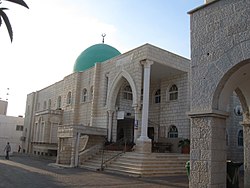
Summary
Kafr Bara or Kfar Bara (Arabic: كفر برا; Hebrew: כַּפְר בַּרָא) is an Arab locality in Israel in situated in its Central District. The small village, located near the Green Line, is often considered a part of the Arabs' Little Triangle along with the cities of Kafr Qasim and Jaljulia. In 2022 its population was 3,946.[1]
Kafr Bara
| |
|---|---|
| A transcription(s) | |
| • ISO 259 | Káper Báraˀ |
| • Also spelled | Kafar Bara (official) Kfar Bara (unofficial) |
 A mosque of Kafr Bara in 2010 | |
 Kafr Bara | |
| Coordinates: 32°7′50″N 34°58′19″E / 32.13056°N 34.97194°E | |
| Grid position | 147/170 PAL |
| District | Central |
| Area | |
| • Total | 9,387 dunams (9.387 km2 or 3.624 sq mi) |
| Population (2022)[1] | |
| • Total | 3,946 |
| • Density | 420/km2 (1,100/sq mi) |
| Name meaning | Khirbet Kafr Bara, "The ruin of the village of Bara"[2] |
History edit
Pottery and glass dating from the Roman period (second century CE) and early Byzantine period (fourth century and beginning of fifth century CE), have been found in a burial cave at Kafr Bara.[3] Various agricultural installations, including a winepress, dating from Byzantine era has also been excavated.[4] Archaeological excavations have revealed remains, apparently from a rural settlement from the Byzantine and Early Islamic periods (sixth–ninth centuries CE).[5]
Ottoman era edit
In 1517, the village was included in the Ottoman Empire with the rest of Palestine, and in the 1596 tax-records it appeared located in the Nahiya of Jabal Qubal, part of Nablus Sanjak. It had a population of 20 Muslim households, who paid a fixed tax-rate of 33,3 % on agricultural products, including wheat, barley, summer crops, and goats and/or beehives; a total of 2,920 akçe. 5/6 of the revenue went to a Waqf.[6]
British Mandate era edit
At the 1931 census of Palestine, conducted by the British Mandate Kafr Bara had 95 inhabitants, all Muslims, in a total of 19 houses.[7]
In the 1945 statistics the population of Kafr Bara was 150, all Muslims,[8] who owned 3,959 dunams of land according to an official land and population survey.[9] Of this, 10 dunams were for citrus and bananas, 12 were plantations and irrigable land, 1,841 used for cereals,[10] while 14 dunams were built-up (urban) land.[11]
1948, and aftermath edit
Since 1948, Kafr Bara has been part of the newly founded State of Israel.[citation needed]
Demographics edit
Kafr Bara had a population of 3,274 in the 2014 census.[12]
See also edit
References edit
- ^ a b "Regional Statistics". Israel Central Bureau of Statistics. Retrieved 21 March 2024.
- ^ Palmer, 1881, p. 234
- ^ Masarwa, 2008, Kafr Bara Final Report
- ^ Eshed, 2017, Kafr Bara Final Report
- ^ Abu Fana, 2010, Kafr Bara Final Report
- ^ Hütteroth and Abdulfattah, 1977, p. 131
- ^ Mills, 1932, p. 59
- ^ Government of Palestine, Department of Statistics, 1945, p. 21
- ^ Government of Palestine, Department of Statistics. Village Statistics, April, 1945. Quoted in Hadawi, 1970, p. 75
- ^ Government of Palestine, Department of Statistics. Village Statistics, April, 1945. Quoted in Hadawi, 1970, p. 126
- ^ Government of Palestine, Department of Statistics. Village Statistics, April, 1945. Quoted in Hadawi, 1970, p. 176
- ^ "לוח 3.- אוכלוסייה( 1), ביישובים שמנו מעל 2,000 תושבים( 2) ושאר אוכלוסייה כפרית Population (1) of localities numbering above 2,000 Residents (2) and other rural population". Archived from the original on 3 October 2015. Retrieved 2 October 2015.
{{cite journal}}: Cite journal requires|journal=(help)
Bibliography edit
- Abu Fana, Mohammed (11 February 2010). "Kafr Bara Final Report" (122). Hadashot Arkheologiyot – Excavations and Surveys in Israel.
{{cite journal}}: Cite journal requires|journal=(help) - Eshed, Vered (6 August 2017). "Kafr Bara Final Report" (129). Hadashot Arkheologiyot – Excavations and Surveys in Israel.
{{cite journal}}: Cite journal requires|journal=(help) - Government of Palestine, Department of Statistics (1945). Village Statistics, April, 1945.
- Hadawi, S. (1970). Village Statistics of 1945: A Classification of Land and Area ownership in Palestine. Palestine Liberation Organization Research Center.
- Hütteroth, Wolf-Dieter; Abdulfattah, Kamal (1977). Historical Geography of Palestine, Transjordan and Southern Syria in the Late 16th Century. Erlanger Geographische Arbeiten, Sonderband 5. Erlangen, Germany: Vorstand der Fränkischen Geographischen Gesellschaft. ISBN 3-920405-41-2.
- Masarwa, Marwan (11 February 2008). "Kafr Bara Final Report" (120). Hadashot Arkheologiyot – Excavations and Surveys in Israel.
{{cite journal}}: Cite journal requires|journal=(help) - Mills, E., ed. (1932). Census of Palestine 1931. Population of Villages, Towns and Administrative Areas. Jerusalem: Government of Palestine.
- Palmer, E.H. (1881). The Survey of Western Palestine: Arabic and English Name Lists Collected During the Survey by Lieutenants Conder and Kitchener, R. E. Transliterated and Explained by E.H. Palmer. Committee of the Palestine Exploration Fund.
External links edit
- Welcome To Kafr Bara
- Survey of Western Palestine, Map 14: IAA, Wikimedia commons


